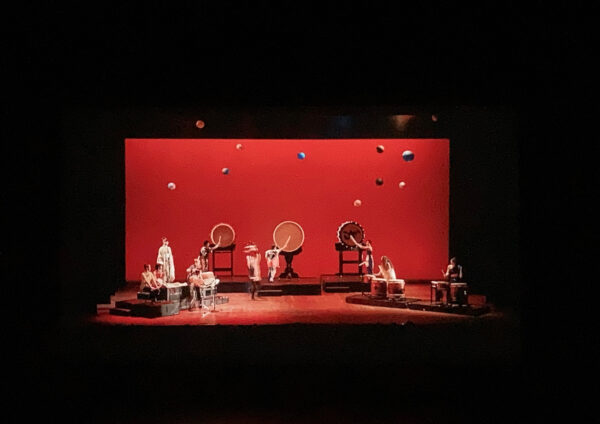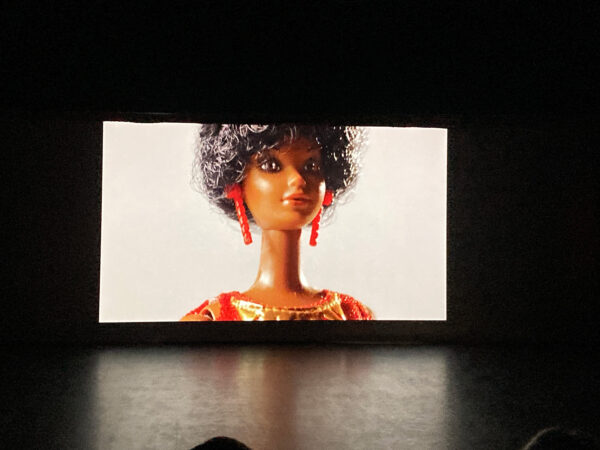The Flatland Film Festival is the oldest program of the Louise Hopkins Underwood Center for the Arts (LHUCA), an institution that showcases visual and performing arts in Lubbock. The festival predates their monthly First Friday market event, which is a popular and perhaps more well-known program to those that live in the area. This is the 20th year of screenings, LHUCA Executive Director Lindsey Maestri noted to the audience on the film festival’s opening night earlier this month. The museum’s website states this program is “the perfect opportunity to watch independent films for the very first time,” which is an appropriate assessment.
Over a period of three days, four feature-length films were shown, alongside three programming blocks of shorts. All screenings took place at LHUCA’s Firehouse Theatre, which has approximately 100 seats in its auditorium-style venue. Seats begin at floor-level and rise upwards several rows, and face a stage backed by a theater-sized projection screen, meaning the space can accommodate live productions as well as digital film screenings. Films were accepted by submission through FilmFreeway, a film open call platform, and Programs Manager Mary Hogan coordinated the selections. The resulting program was a mostly English-language grouping of films with a regional focus. Relatively similar screen time was given to both the feature films and the short film screening blocks.
Below are some thoughts on the four feature films that were a part of this year’s festival.
****
Finding Her Beat is a documentary film directed by Dawn Mikkelson and Keri Pickett that delves into the world of Taiko drumming, a traditional Japanese art form. The film primarily focuses on TaikoArts Midwest, a group of Taiko artists based in the United States, and their efforts to bring together women Taiko players from various backgrounds to create HERbeat, a historic performance in Minneapolis.
The documentary introduces us to Jennifer Weir, the director of TaikoArts, her wife Megan Chao Smith, and Josie Smith-Weir, their daughter. It also highlights the work of Tiffany Tamaribuchi, a prominent figure in the Taiko community.
The film explores the historical context of Taiko, suggesting that it evolved into a performance art after World War II, primarily performed by men. The story unfolds over 17 months, during which this group of artists seek to break the mold of exclusion and isolation that women Taiko players often experience. The goal is to unite these talented artists for HERbeat, which Weir is organizing to bring the spotlight to women in Taiko.
The film also delves into the cultural significance of Taiko, portraying it as a percussion art form that can be theatrical, narrative, and dramatic. The international range of the women joining the performance adds a number of complexities to the production, like logistical challenges, differing needs for each troupe’s representation in the performance, venue issues, and the looming global pandemic (the film was shot in the months leading up to February 2020).
The encroaching threat of COVID-19, had already disrupted events in Japan by the time that HERbeat began rehearsals. The host venue, St. Paul’s Ordway Center for the Performing Arts, closed immediately after the performance took place. This timeline adds a fascinating layer of urgency to the experience of documenting the process, and also makes the film a unique time capsule of pre-pandemic life.
The film explores the hunger for the spotlight among these talented Taiko players and the need to find a way to share it collectively. The question arises: Will this diverse group of artists be able to come together successfully, despite their differences?
In Finding Her Beat, directors Mikkelson and Pickett paint a compelling picture of the aspirations of women in Taiko drumming, emphasizing the importance of unity and challenging barriers to artistic production. The film’s narrative is punctuated with powerful performances and personal stories, making it an engaging and thought-provoking exploration of the world of Taiko.
****

“Hummingbirds,” co directed by Silvia Del Carmen Castaños, Estefania “Beba” Contreras, Miguel Drake-McLaughlin, Diane Ng, Ana Rodriguez-Falcó, and Jillian Schlesinger
Hummingbirds is a documentary film co-directed by Silvia Del Carmen Castaños, Estefania “Beba” Contreras, Miguel Drake-McLaughlin, Diane Ng, Ana Rodriguez-Falcó, and Jillian Schlesinger. It offers an intimate and authentic glimpse into the lives of two young women (Castaños and Contreras) in Laredo, Texas, as they navigate issues of identity, belonging, and the pursuit of their dreams against the backdrop of the Texas-Mexico border.
The film begins with the two women sitting atop a car, playfully pointing out stars in the night sky. This simple act sets the tone for the documentary, where the filmmakers themselves become the stars of their story. They engage in candid conversations about memory and progress, ultimately realizing that their connection and familiarity with each other are what truly matter.
One of the film’s central themes revolves around Estefania’s quest to update her residency status, which would allow her to travel and work freely. She finds herself in a state of limbo, pondering what it means to be a resident and what rights come with that status. As the filmmakers grapple with their bicultural identities and experiences of deportation and detention, they also engage in acts of rebellion, such as breaking into buildings and protesting against border patrol.
The film captures the vibrancy and authenticity of South Texas’ youth, depicting their strong convictions and concerns about their experiences in a society that has often excluded them.
Throughout the documentary, the girls speak in Spanglish, reenact memes from the 2010s, and share moments of youthful exuberance. The film is a snapshot of their lives, shot during the summer of 2020, highlighting their deep bond and their difficulty of envisioning life without each other.
As Hummingbirds unfolds, it raises the poignant question of whether these young women will eventually leave their hometown, Laredo, before they outgrow it. Their shared experiences, struggles, and aspirations form the heart of this documentary, making it a compelling and relatable portrayal of youth, friendship, and the pursuit of a sense of belonging in a complex world. The film’s authenticity and raw emotion draw viewers into the lives of its subjects, leaving them with much to reflect upon.
****
Library Stories: Books on the Backroads, directed by Mary Lance & Ben Daitz, is a heartwarming documentary that sheds light on the vital role rural libraries play in small communities across New Mexico. The film follows the efforts of the New Mexico Rural Libraries Initiative, showcasing the unique challenges and inspiring stories of several rural libraries and their dedicated librarians.
The film then explores case studies of these libraries, like those in Vallecitos, La Madera, and Dixon, each of which has its own challenges and stories. In Vallecitos, the local library is housed in a former hardware store, and now serves as a central community hub, while Dixon’s library is closely integrated with a co-op that provides essential services to the town. These libraries are often 501(c)(3) organizations in unincorporated areas and rely on their own fundraising efforts, which often means that the funds must come from the local community.
The documentary underscores how rural libraries offer a sense of legitimacy and community identity to small towns. They serve as essential gathering places for people who may lack access to basic services like electricity, water, or reliable cell phone coverage. The library’s role extends beyond books, providing opportunities for socialization and facilitating various programs, such as seed libraries and parent groups.
One particularly touching aspect of the film is the personal connection between librarians and readers in these communities. The librarians make a concerted effort to engage residents, especially children, through interactive and narrative programs, like summer reading programs for young readers. These initiatives help foster a sense of belonging and encourage the development of “incipient readers,” as one librarian says.
Library Stories: Books on the Backroads is a powerful testament to the resilience of rural libraries and their importance in maintaining the fabric of small communities. The film conveys the critical role these libraries play in providing not only books, but also essential resources and a sense of community. It highlights the dedication of librarians who go above and beyond to serve their towns, and underscores the profound impact these libraries have on the lives of residents, especially the young readers who represent the future of these tight-knit communities.
****
Black Barbie, directed by Lagueria Davis, is a documentary that delves into the history and cultural impact of the Barbie doll, specifically focusing on the creation and evolution of Black Barbie. Directed by Lagueria Davis, the film offers a fascinating exploration of the doll’s significance in the context of race, representation, and societal change.
The film begins with a revelation: Davis’s cousin, Beulah Mae Mitchell (who is referred to as Davis’s “aunt” in the film), was a doll maker for Mattel in 1955. Mitchell, who was originally from Fort Worth, was later asked to collaborate on the production of Mattel’s first Black Barbie doll. The film goes on to interview other Black doll designers working for Mattel, and draws an illuminating historical timeline of Black doll design and production by the documentary’s midpoint.
One of the central themes explored in the film is the historical context of Black Barbie’s development. It delves into the era of “Operation Bootstrap,” a grassroots civil engagement program founded by Robert Hall and Louis Smith in the 1960s, and the establishment of the Shin Dana Toy Company in 1977. Kitty Black Perkins, the first Black Barbie designer, played a crucial role in crafting the doll’s identity. The film highlights the uniqueness of Black Barbie’s style, which drew inspiration from Diana Ross, presenting the doll as “black, beautiful, and dynamite.”
The documentary sheds light on the challenges and complexities of introducing Black Barbie into the market. While collectors and enthusiasts appreciated her significance, the film touches upon the fact that not all Black entertainers and consumers remember her as a prominent figure in the zeitgeist. This leads to a discussion about the marketing strategies employed by Mattel and how Black Barbie was positioned within the Barbie universe.
The film also explores the ethical dimension of discussing complex issues like racism with children through toys. The Clark Doll test of 1940, in which children were shown physically identical dolls in Black and White skin tones, is invoked for its pertinence to the question of how representation in children’s products affects self-esteem. The film then presents a panel of educators and theorists who recreate a similar, but not identical, test with groups of non-White children. In these, a range of racially typed dolls are offered to the children and paired with questions about their appearance. These filmed interviews of children and of experts are quite interesting in themselves, but feel disconnected from the historical investigation of Black dolls. Davis narrates the film and, over time, the direction of research becomes quite broad.
Black Barbie offers viewers a nuanced perspective on the evolution of the Barbie brand and its impact on culture, identity, and the ongoing struggle for representation. It encourages a critical examination of how consumer products can reflect and shape societal values and expectations. The documentary’s interviews with key figures in the history of Barbie, as well as contemporary voices, add depth to its exploration of these complex themes.
****
Texas has several regional film festivals, and they are an excellent way to engage with contemporary independent filmmakers. This year’s Flatland Film Festival showed documentaries which speak to the present day, as well as issues relevant to a Texas audience.
The Flatland Film Festival ran from September 21–23 at LHUCA in Lubbock, Texas.
William Sarradet is the Assistant Editor for Glasstire.





